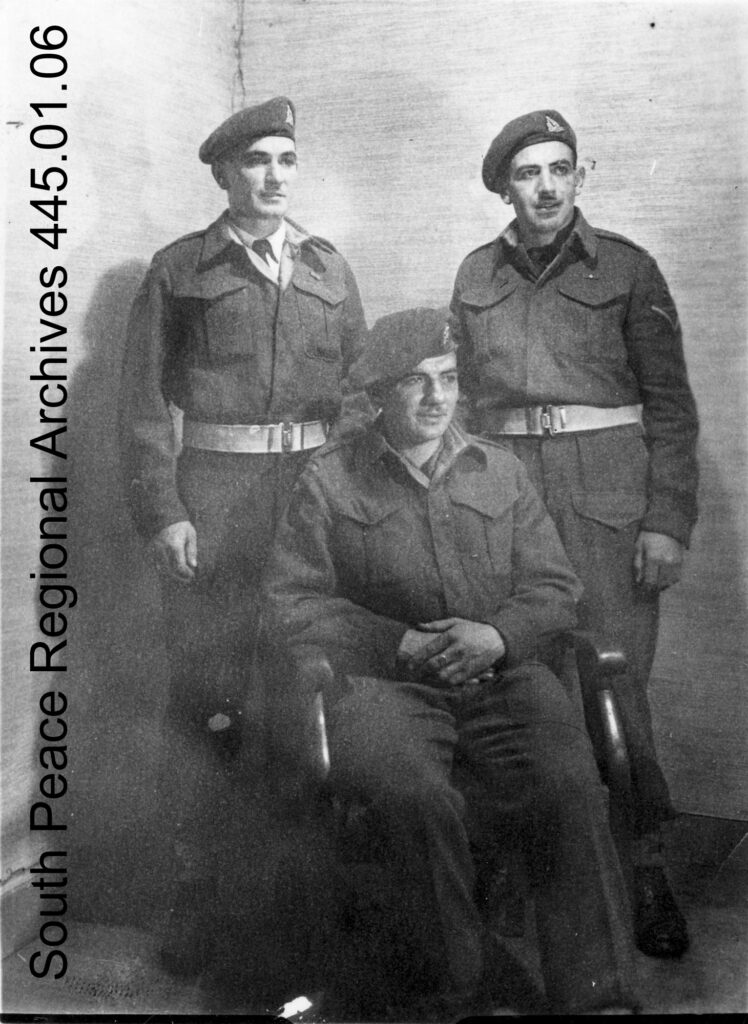Clarence is seated in the photograph.
Regimental Number: M66795
Clarence, born on March 7, 1920 at Grande Prairie, Alberta, was the oldest in Isaac and Bertha Boyer’s family of four children. He had two brothers, Ray and Harry and one sister, Ruth. Isaac, who went by Ike, was born in Annville, Pennsylvania, USA in 1881. In 1899, he moved to South Dakota where he worked on a ranch. After hearing about the possibility of land ownership in Northern Alberta, Ike travelled to the Peace Country in 1911. In June 1912, he filed a homestead application on NE 35-72-4-W6 in an area of Bezanson known as Kleskun Hills. The farm was located between Kleskun Hill and Kleskun Lake. On June 18, 1919, Ike married a widow, Bertha M. Delaney (born in North Nation Mills, Quebec on March 25, 1985), who had just arrived in Grande Prairie with her six children. The Boyer and Delaney children all attended the East Kleskun School. Clarence’s first teacher was Dorothy (Morrison) Leslie. By age 14, Clarence had to leave school and take over the farm duties as his father had become so crippled that he could not work. During the 1930’s, Clarence and Archie Delaney hunted and trapped squirrels which were sold for 15 cents each. They also hunted coyotes and sold the hides. In the spring of 1935, Clarence worked in the bush hauling out logs for the Fitzpatrick Mill. Later on, Archie and Clarence went to work for Charlie Moon’s Mill on the Wapiti River for one winter. Lumber was provided in lieu of wages.
In October 1941, Clarence enlisted with the Royal Canadian Army Service Corps. He was transferred to Camrose for two months of basic training for truck and mechanic work following which; advanced training was undertaken at Red Deer. In May or June, 1942, Clarence sailed from Halifax to Liverpool, England. At Liverpool, the recruits were transported by trucks to the Aldershot Canadian Military Camp. Upon arrival, Clarence was transferred to the Royal Canadian Signal Corps. The R.C.S.C. was a component within the Canadian Armed Forces’ Communications and Electronics Branch and was a combat support corps of the Canadian Army. Clarence successfully completed a Class B Mechanic Course as well as a Class A Battery-Charging Operator Course. It was Clarence’s responsibility to charge the batteries for 60 to 70 vehicles and the batteries for the radios and Morse-Code signaling machines. During the summer and fall of 1943, Clarence’s unit moved up and down the coast of England, Scotland and Wales. The following November, the unit set sail at Glasgow for Italy and landed on the tip of Sicily. They came under heavy fire and the hospital ship sank. The unit disembarked under the cover of darkness and had to walk down the gang plank and jump into water that came up to their armpits while holding their pack and gun above their heads. The unit moved into an old, well-built schoolhouse in Syracuse and that is where they spent the Christmas of 1943. Clarence, along with three or four soldiers, drove a 1500-weight vehicle that had been provided by the 8th Division, every 2nd night from the southern tip of Sicily through the mountains to the north-end to deliver vital message by means of signals. Finally, the entire unit pushed forward to the northern end of Sicily and crossed the sea on barges or large ferries. Once in Italy, Clarence once again was in charge of keeping the equipment batteries charged. Once in Italy, the Princess Dragoons and Guards were split into infantry units. The unit moved up through Italy until they reached Naples and then crisscrossed from coast to coast. By the end of December or early January, the unit was about 20 miles from the heavily shelled and bombed city of Ortona. By Christmas of 1944, the unit entered Ravenna and was scheduled to have a short break from duty; however, around midnight on Christmas Eve, the Germans began a barrage of shelling. In the spring of 1945, Clarence’s unit boarded a ship at Livorno and crossed to France to regroup. From there, the unit moved up through Belgium, which was more-or-less liberated; however, when they reached Holland, the fighting was still fierce. When Germany surrendered, Clarence’s unit had just reached the German border. Here they celebrated, regrouped and prepared to return to England – a journey that did not occur until July or August of 1945. Once in England, Clarence was hospitalized for three months with pneumonia and missed his scheduled draft home.
Finally, Clarence arrived home in March of 1946 and continued to farm the Boyer home quarter of land. He subsequently purchased the SW-25-72-4-W6 by means of a loan through the Veterans Land Act. In an effort to subsidize the farm income, Clarence worked in sawmills during the winter months. On April 23, 1948, he married Ruby Norton and they had four children; Brian, Sharon, Verna and Wayne. Once Clarence became crippled and could no longer manage the heavy farm and bush work, the family moved to Grande Prairie. While in Grande Prairie, Clarence quickly found employment with Massey Harris following which, he went to work for Sergeant Motors as a salesman – a position he kept for 12 years. Thereafter, he was hired by Shannon’s to manage their machine shop and sell machinery for the next 10 years. Once retired, Clarence spent his time volunteering at the Pioneer Museum restoring artifacts until he lost his eyesight in 1987. He was a member of the West Smoky Legion No. 244 in Bezanson and the Grande Prairie Legion Branch No. 54 for many years. He passed away on July 29, 1993 in Grande Prairie and was buried at the Grande Prairie Cemetery.
Contributed by Wanda Zenner
Sources:
South Peace Regional Archives Land Database
Wikipedia
Interview with Brian Boyer – son
The Delaney-Boyer Family History Book
Herald Tribune – Obituary July 30, 1993
Smoky River to Grande Prairie p. 119
